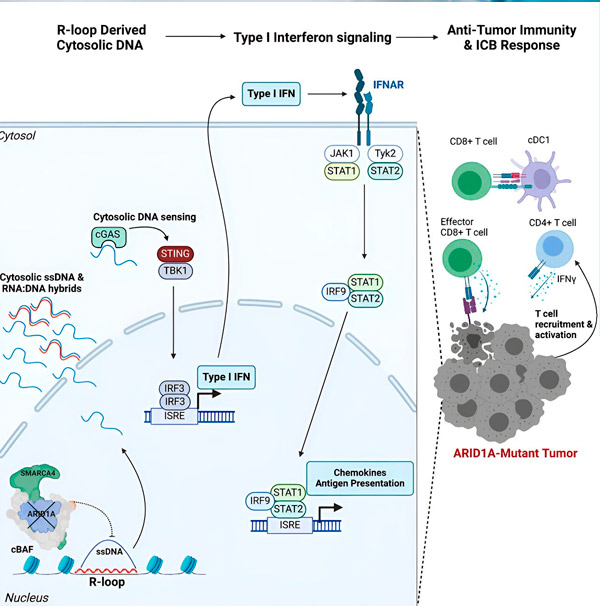ARID1A Gene Mutation Makes Tumors Sensitive to Immunotherapy
Sist anmeldt: 14.06.2024

Alt iLive-innhold blir gjennomgått med medisin eller faktisk kontrollert for å sikre så mye faktuell nøyaktighet som mulig.
Vi har strenge retningslinjer for innkjøp og kun kobling til anerkjente medieområder, akademiske forskningsinstitusjoner og, når det er mulig, medisinsk peer-evaluerte studier. Merk at tallene i parenteser ([1], [2], etc.) er klikkbare koblinger til disse studiene.
Hvis du føler at noe av innholdet vårt er unøyaktig, utdatert eller ellers tvilsomt, velg det og trykk Ctrl + Enter.

Immunotherapy has revolutionized cancer treatment in recent years. Instead of directly targeting tumors, immunotherapy directs patients' immune systems to attack tumors more effectively. This is especially effective for some difficult-to-treat cancers. However, less than half of all patients with cancer respond to current immunotherapies, creating an urgent need to identify biomarkers that can predict which patients are most likely to benefit from treatment.
Recently, scientists noticed that patients whose tumors have an ARID1A gene mutation are more likely to respond positively to immune checkpoint blockade, a type of immunotherapy that works. Keeping cancer-fighting immune cells activated.
Because the ARID1A gene mutation is present in many cancers, including endometrial, ovarian, colorectal, gastric, liver, and pancreatic cancers, Salk Institute researchers wondered how it might contribute to treatment sensitivity and how clinicians could use this information to personalize cancer treatment for each patient.
Their new study, published in the journal Cell shows that the ARID1A mutation makes tumors sensitive to immunotherapy by recruiting cancer-fighting immune cells to the tumor through an immune response. Similar to antiviral.
The researchers suggest that this mutation and antiviral immune response could be used as a biomarker to better select patients for specific immunotherapies, such as immune checkpoint blockade. These results also encourage the development of drugs that target ARID1A and its associated proteins to make other tumors more sensitive to immunotherapy.
“This could really change the outcome of cancer treatment for patients,” says Associate Professor Diana Hargreaves, senior author of the study. "Patients with the ARID1A mutation already have an immune response, so all we need to do is boost that response with immune checkpoint blockade to help them destroy their tumors from the inside."
Although people with ARID1A mutations were known to respond well to immune checkpoint blockade, the exact relationship between the two remained unclear. To clarify the mechanism of this process, scientists from the Salk Institute used mouse models of melanoma and colorectal cancer with an ARID1A mutation and functional ARID1A.

Source: Cell (2024). DOI: 10.1016/j.cell.2024.04.025
The team observed a powerful immune response in all models with the ARID1A mutation, but not in those where ARID1A was functional, supporting the idea that the ARID1A mutation is indeed driving this response. But how does it work at the molecular level?
“We found that ARID1A plays an important role in the nucleus by maintaining the correct organization of DNA,” says Matthew Maxwell, first author of the study and a graduate student in the Hargreaves lab. "Without functional ARID1A, free DNA can be excised and released into the cytosol, which activates the desired antiviral immune response, which can be enhanced by immune checkpoint blockade."
The ARID1A gene encodes a protein that helps regulate the shape of our DNA and maintain genome stability. When ARID1A mutates, a chain of events similar to a Rube Goldberg machine is triggered in cancer cells.
Initially, the absence of functional ARID1A results in the release of DNA into the cytosol. The cytosolic DNA then activates an antiviral alarm system, the cGAS-STING pathway, as our cells are adapted to mark any DNA in the cytosol as foreign to protect against viral infections. Ultimately, the cGAS-STING pathway recruits the immune system to recruit T cells to the tumor and activates them into specialized cancer killer T cells.
At each step, dependent on the previous one, this chain of events—ARID1A mutation, DNA escape, cGAS-STING alert, T cell recruitment—results in an increase in the number of cancer-fighting T cells in the tumor. Immune checkpoint blockade can then be used to ensure that these T cells remain activated, enhancing their ability to defeat cancer.
"Our findings provide a new molecular mechanism by which the ARID1A mutation may contribute to the antitumor immune response," says Hargreaves. "The most exciting thing about these results is their translational potential. We can use ARID1A mutations to select patients for immune checkpoint blockade, and we are now seeing a mechanism by which drugs that inhibit ARID1A or its protein complex could be used to further enhance immunotherapy in other patients."
By describing the mechanism by which immune checkpoint blockade is more effective for cancers with an ARID1A mutation, the researchers provide a rationale for clinicians to prioritize this immunotherapy for patients with an ARID1A mutation. These results represent an important step in personalizing cancer treatment and inspire the development of new therapies aimed at inhibiting ARID1A and its protein complex.
In the future, the Salk Institute team hopes that their findings will improve outcomes for patients with various types of cancer associated with ARID1A mutations, and intend to explore this clinical translation in collaboration with the University of California, San Diego.
